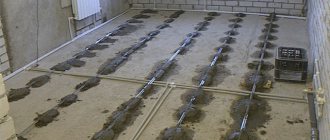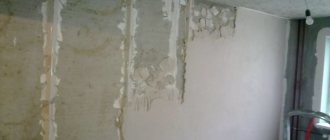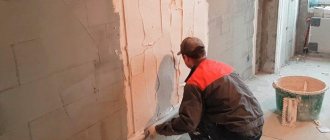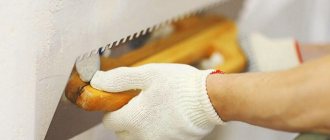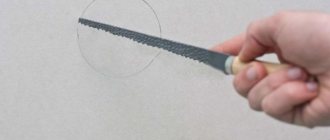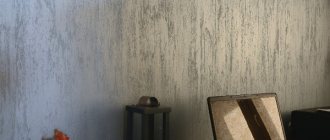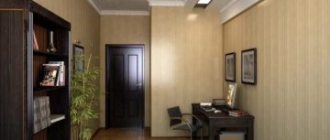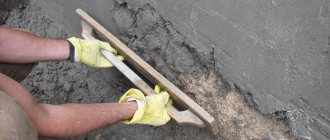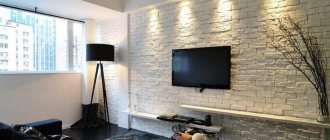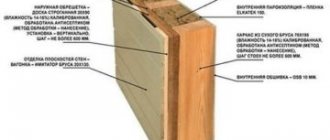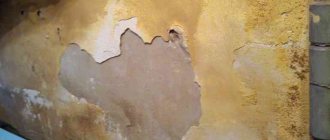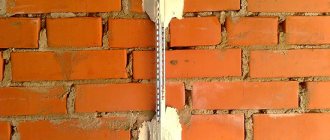6189 0 0
SlavagodM October 20, 2016Specialization: master of interior and exterior finishing (plaster, putty, tiles, drywall, lining, laminate, etc.). In addition, plumbing, heating, electrical, conventional cladding and balcony extensions. That is, the renovation of an apartment or house was done on a turnkey basis with all the necessary types of work.
Putty with starting mixture on beacons
Starting mixtures are usually used to level walls and ceilings, but this, of course, is not the final finish. The goal in this case is to create an even base for the cladding - this can be wallpapering or puttying with a finishing mixture for painting (it can also be decorative). In addition to the video provided here, I also want to make some clarifications.
Much about starting putty or plaster
Note. I will not describe everything in detail, since a lot is shown in the video, and the article will only be a clarification and addition.
Preliminary work
Plastering walls along beacons is carried out after preparatory procedures to obtain a high-quality design of the premises.
The following stages of preparatory work are necessary:
- inspection of wall panels;
- surface measurement by level;
- cleaning surfaces from dust, dirt, old individual coatings;
- padding;
- fixation of reinforcing mesh.
It is necessary to inspect the wall panels for defects and protrusions. Irregularities are marked on the wall using a marker or pencil. Difficult areas will require careful leveling.
At the next stage, the walls are cleaned of old paint, plaster and other finishing materials to the base. The marked depressions are eliminated using putty, and the protrusions are leveled. Differences on the wall panel should not be more than 12 mm. The use of a laser level is recommended.
Then the level of the flat surface is changed and places for installing beacons are marked. The walls are cleaned of construction dust and can be vacuumed.
The next step is priming the base. The primer helps protect surfaces from moisture, mildew and mold. The composition is selected taking into account the surface material and the type of room (kitchen, living room). Priming increases the adhesion of the base and reduces the risk of delamination of the plaster.
When applying a dense layer of plaster mixture (more than 10 mm) and then laying tiles after drying, additional surface reinforcement will be required.
You need to select a reinforcing mesh made of glass fibers, metal or polyethylene. The mesh is fixed using a special solution or dowels.
Correct grouting of walls
Before painting or wallpapering, the leveled walls need to be prepared. Properly performed grouting plays an important role; before starting work, it is necessary to knead the plaster, but with a more liquid consistency. The wall surface must be moistened gradually, no more than 1 m². The solution is applied in a thin layer to the selected surface and smoothed with a trowel until no more solution remains on the instrument. All excess must be removed; during operation, the ironer must be held at an angle of 45 degrees. In this way, it is necessary to process all the walls, taking into account the overlap between the selected squares. It is advisable to complete the work without interruptions; you can be distracted by mixing the solution.
Do not apply plaster in a draft, an open window or at high temperatures in the room, this will lead to the appearance of significant cracks.
Construction stores and businesses today offer a wide range of materials for repairs. Thanks to this, you can choose metal beacons, plaster, a rule, a spatula and other necessary tools, of a suitable price and made of a certain material. The work of leveling walls using metal beacons does not require extensive knowledge and skills in construction or repair. Thanks to this fact, you can level the walls yourself and choose better materials for the job. With a complete lack of experience in construction work, it is important to initially be patient, since the work takes a lot of time and you need to be prepared for difficulties, but do not be afraid of them, start and do it. Before starting work, it is very important to initially study everything carefully, remember important details, watch a video on how to align walls according to beacons, and then boldly begin work. Drawing up a plan will allow you to avoid major mistakes and ensure the achievement of the expected result.
Source
Tools
Putty on beacons is made using the following tools when leveling the panels:
- beacons;
- primer mixture;
- construction mixer;
- set of spatulas;
- building level;
- drill with attachments;
- painting mesh;
- wide brush;
- plaster;
- sheets of sandpaper;
- rollers;
- rule;
- abrasive mesh;
- deep containers.
Depending on the base material and the putty application technique, beacons made of plastic, metal, string, reusable steel, etc. can be used.
Plastic beacons are lightweight, easy to fix and remove. They are not susceptible to mold or rust and can remain in the putty composition. Such products are not suitable for exterior decoration.
Galvanized ones are affordable and easy to install. The products are produced in standard sizes 6-10 mm.
String beacons are a system of self-tapping screws with wire. To install the elements, dowels and a hammer drill are used. The design is easy to use and affordable.
Ways to level walls
To level the walls yourself, putty, plaster, or drywall can be used. Which material is best to choose for the job depends on various factors, the nature and size of unevenness, the humidity in the room, and also for what purposes the room is used are considered. Plaster is most often used for leveling walls; it is universal and suitable for both living rooms and office spaces. Drywall sheets are usually used if the unevenness on the walls is quite significant and leveling with plaster will be more expensive. Further work on wall cladding can be carried out immediately after installation of drywall. Puttying is carried out immediately before painting or wallpapering the walls. Leveling using beacons and plaster can be done independently, without special knowledge and training, the main thing is to familiarize yourself with the procedure of work and remember the important details.
Beacons are made of galvanized steel or aluminum. The latter are more popular because they do not rust and can be left in the plaster. The most common beacons in the form of planks are produced with a length of 3 meters. But it is best to remove the beacons, since the layer of plaster over the metal can crumble over time and spoil the appearance of the wall. It does not matter what material the beacons are made from, they are intended only for applying plaster and are a guide. An important point when using beacons to level walls is that they must be securely fixed in the correct position, this will greatly simplify the work and ensure the expected, high-quality result.
Necessary tools for leveling walls:
- Lighthouses
- Construction mixer
- Primer
- Putty knife
- Painting mesh
- Level
- Paint brush (wide)
- Plaster
- Putty
- Rule
Installation of beacons
The beacons are designed to create a contour for applying the plaster mixture and subsequent leveling of the walls. The accuracy of the installation of beacons determines the parameters of a smooth surface.
At the next stage, the beacons are fixed. To install the profiles at a given level, you will need to stretch a strong thread or thin cord. Taking into account the tension level, screws are screwed into the wall, which will become the basis for the beacons. Then, using a small amount of putty, beacons are attached to the surface.
The arrangement of elements is carried out from the corner part. According to standards, the gap between the beacons should be 120-150 mm. The size of the gaps may vary depending on the method of applying the plaster, the quality of the finishing material and the dimensions of the room being decorated. On smooth walls with small uneven areas, the elements are installed only in a few places on the wall.
Do-it-yourself slope puttying technique
Puttying window slopes with your own hands is quite doable for a non-professional. You just need to follow all the technical recommendations step by step.
Preparation of the working surface indoors and outdoors
Initially, inspect the base on which the putty will be applied. The old plaster should hold firmly. If there are cracks, then the base requires dismantling. If in doubt, tap the surface with the wooden handle of some instrument. Where there are voids inside, the sound will be different from those places where the plaster fits tightly.
If cracks appear in the plaster, it should be completely removed from the entire surface of the window slope
Remove old plaster with a chisel and hammer or hammer drill. The chipped edges are cleaned with a brush with metal bristles, the protruding parts are cleaned with a steel spatula, and the base, which does not require major alterations, is cleaned with a coarse grater. Where there are gaps between the frame and the slope, they are foamed or filled with fiberglass for better insulation. The frame is covered with masking tape, the glass with plastic film.
Padding
For slopes, choose one of the types of deep penetration primers:
- acrylic;
- phenolic;
- alkyd;
- glyphthalic.
Types of primers for window slopes
Due to its high toxicity, glypthal soil is used either outdoors or in a well-ventilated room.
First prime the base, then each subsequent putty layer after drying. The primed layer will strengthen the surface, glue dust and large particles together, and allow the next coating to adhere tightly.
Preparation of putty composition
The dry mixture is added as much as is required at the moment.
The dilution proportions are indicated on the bag. You cannot apply it “by eye”, because after some time the solution changes consistency, becoming thicker. The construction mixture is added to the water, but not vice versa. It is poured in a thin stream gradually.
Technology for preparing putty composition
Stir the putty with a construction mixer or an electric drill with a whisk attachment at low speed. At high conditions, bubbles form in the solution, which affect the quality of the substrate. After applying such a composition, depressions and stains form on the surface, and the solution lies unevenly.
After the mixture is diluted, the whisk is rotated in a bucket of clean water. If this is not done, the adhering putty will harden on the tool and then crumble into the newly applied solution. Fragments of the frozen composition will also affect the quality of the mixture - scratches will appear on the slope.
Leveling the surface
The surface is leveled either with plasterboard or putty.
Corners
The first stage is the installation of perforated aluminum corners outside the slope. First, the profile is placed on the starting mixture at the top, having first clearly measured and cut the required length with metal scissors, then along the walls.
A perforated aluminum corner is installed outside the slope
The position of the corners should be clearly adjusted relative to the walls - the outer wings should be flush with the plane. Using a level, set the horizontal and vertical.
Excess putty that protrudes through the holes is removed with a spatula.
Lighthouses
The beacon is installed near the frame on the starting mixture. The beacon and corner serve as guides for a long spatula or rule. After the mixture has hardened, the beacon is removed and the area is puttied.
Scheme for installing beacons in a window slope
In the case of gypsum boards, instead of a beacon, an angular profile is screwed to the frame. The space between the two corners is filled with insulating material (foam plastic, mineral wool, thermal liners, polystyrene foam or foam). Then drywall is screwed to the metal corners.
Applying starting mixture
Initially, all cracks and holes must be filled with starting solution. It should have a thick consistency: fit tightly and firmly fill all defects:
| 1.After the local treatments have dried, the surface must be primed and continuous 2-3 layers no thicker than 6 mm must be applied. | |
| 2. After drying, sand the surface with a coarse float and prime it. |
The surface is prepared for finishing putty.
Applying finishing mixture
The gypsum board and the surface, plastered with the starting solution, are covered with the finishing mixture. After diluting the dry composition with water, the consistency becomes like liquid sour cream. The fractions in this putty are small and not noticeable either visually or to the touch. The solution is applied no thicker than 2-3 mm.
Sanding and painting
After drying, the surface is sanded with a fine-grained grater. After grouting, the plane is checked using side lighting. If necessary, convex areas are sanded until they are level. There is no need to overdo it - you can wipe it down to the starting coating.
The quality of plastering work is checked using side lighting
Water-dispersed or water-based paint is used. If desired, add a color to the dye that matches the color of the walls.
For painting, use a roller, which is passed along the plane 2-3 times. This is the only way the color will be uniform.
Applying putty
Puttying the walls is carried out in 2 stages. First, a rough (base) layer is applied, then the finishing coat. Step-by-step coating of the walls with the composition will provide a high-quality finish without peeling off the putty.
At the first stage, a dense layer of putty is thrown onto the surface and leveled, 4-5 mm should remain to the upper edge of the beacons. After filling the gaps between the profiles, the composition is dried. Then the surface is primed.
The next layer of putty is less dense and is applied carefully. The thickness of the putty composition should slightly exceed the height of the beacons. When leveling, the excess mass is cleared off as a rule.
After the putty coating has dried, it is necessary to apply a thin finishing layer of primer. The coating needs to be leveled. Finally, painting and wallpapering are carried out.
If you plan to lay tiles, the base must be sanded and coated with a primer mixture. When wallpapering or painting, you need to make the walls smooth by treating them with sandpaper. Then 2 layers of putty are applied step by step. It is necessary to process the internal corner areas using a square and a corner spatula.
Tips and tricks
Builders with extensive experience recommend listening to their advice:
Putty with color will eliminate the need to paint the ceiling
- If painting will be done with textured or structural paint, which is dense in consistency, you should opt for a universal putty.
- You can avoid painting a putty ceiling if you use a composition with added color. In this case, the surface will not be bright, but still a pleasant shade, and the work process will be halved.
- In places of high humidity, use cement-based or polymer-based putty. It is advisable not to use gypsum boards even with a moisture-resistant coating.
- When purchasing mixtures, pay attention to the expiration date; fresh is considered to be one that was produced no later than 2 months ago.
- To cover wooden ceilings, use mixtures containing fire-fighting and antifungal additives.
- After stirring the putty, rinse the dirty whisk in clean water. If this is not done, the mixture will harden and sprinkle into the newly added solution.
- Keep spatulas clean while working; a frozen piece of putty will scratch the surface, and trapped dirt will cause streaks.
- Buy putty and primer from the same manufacturer, this will ensure better adhesion between layers and quality of finishing.
Before starting work, tap the plastered ceiling with the handle of a trowel. A change in sound tone will indicate the presence of voids. At this point the plaster must be knocked down.
A painted ceiling is beautiful, cozy and durable. Preparing it for painting is not an easy task, but it can be done, you just need to be patient. But pride will overwhelm the one who copes with all the difficulties.
Have you puttyed the ceiling before painting? What life hacks did you use? Share your experience in the comments.
Frame method
Laying on a metal or wooden frame is used. It is important to remember that the wood must be dry, otherwise defects may occur. Metal is much more acceptable, it has excellent technical characteristics and is more reliable in operation. Guide and rack profiles are used.
First of all, the profile must be attached to the base of the ceiling; the point of attachment to the floor is identified using a plumb line. Rack-mount samples are inserted into the guides. The range between the posts is 0.4-0.6 m.
The sheets are fastened with self-tapping screws. For strength, rack profiles must be attached to hangers. It is important to be careful when working with fasteners to avoid damage.
For a standard sheet, about 100 pieces of self-tapping screws are required. Upon completion of this work, the planes are completely covered with putty (fastening points first).
Each owner chooses the most appropriate method of leveling the walls, based on many factors.
The right approach to work will ensure the best conditions in the room in which the renovation was carried out. Share:
